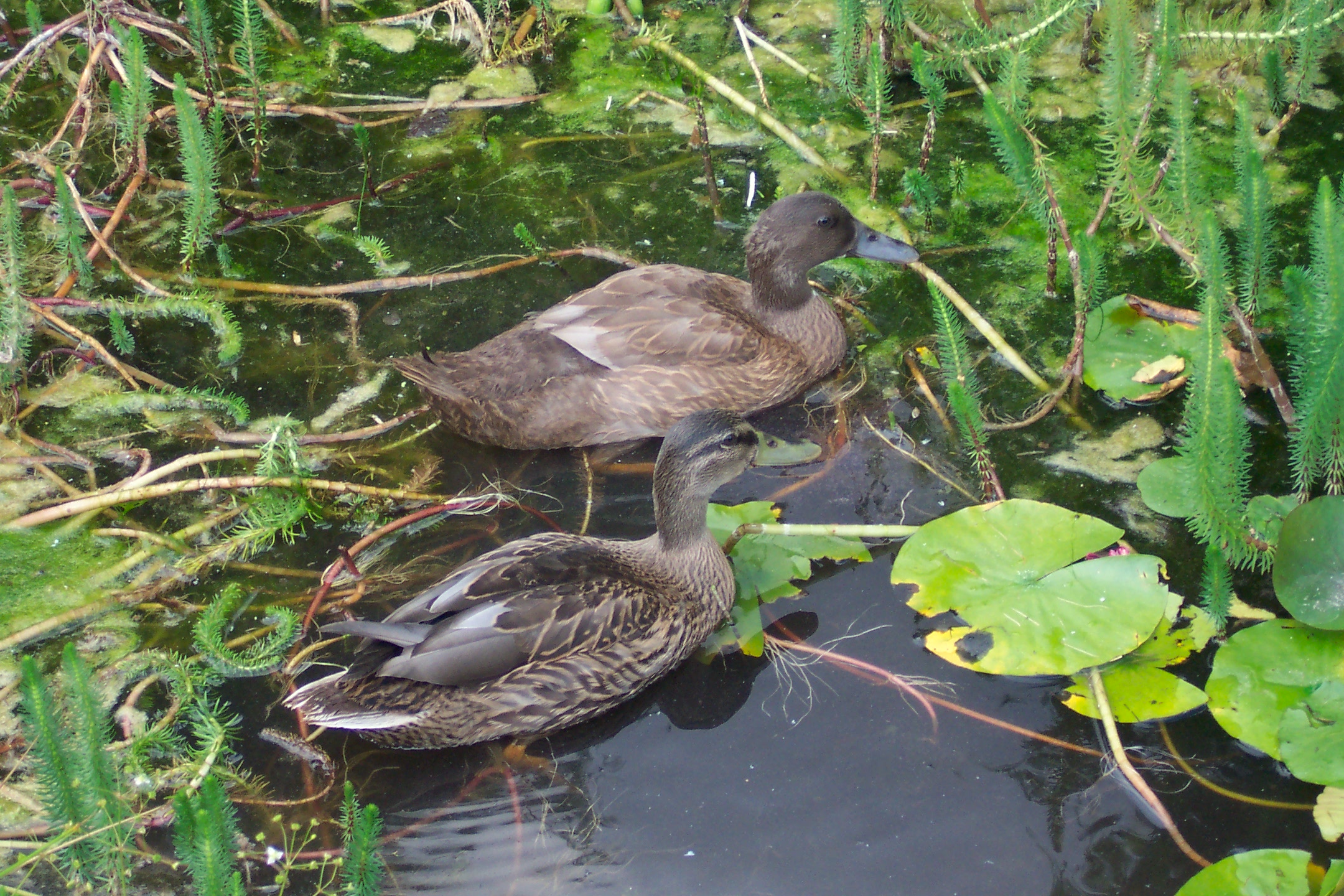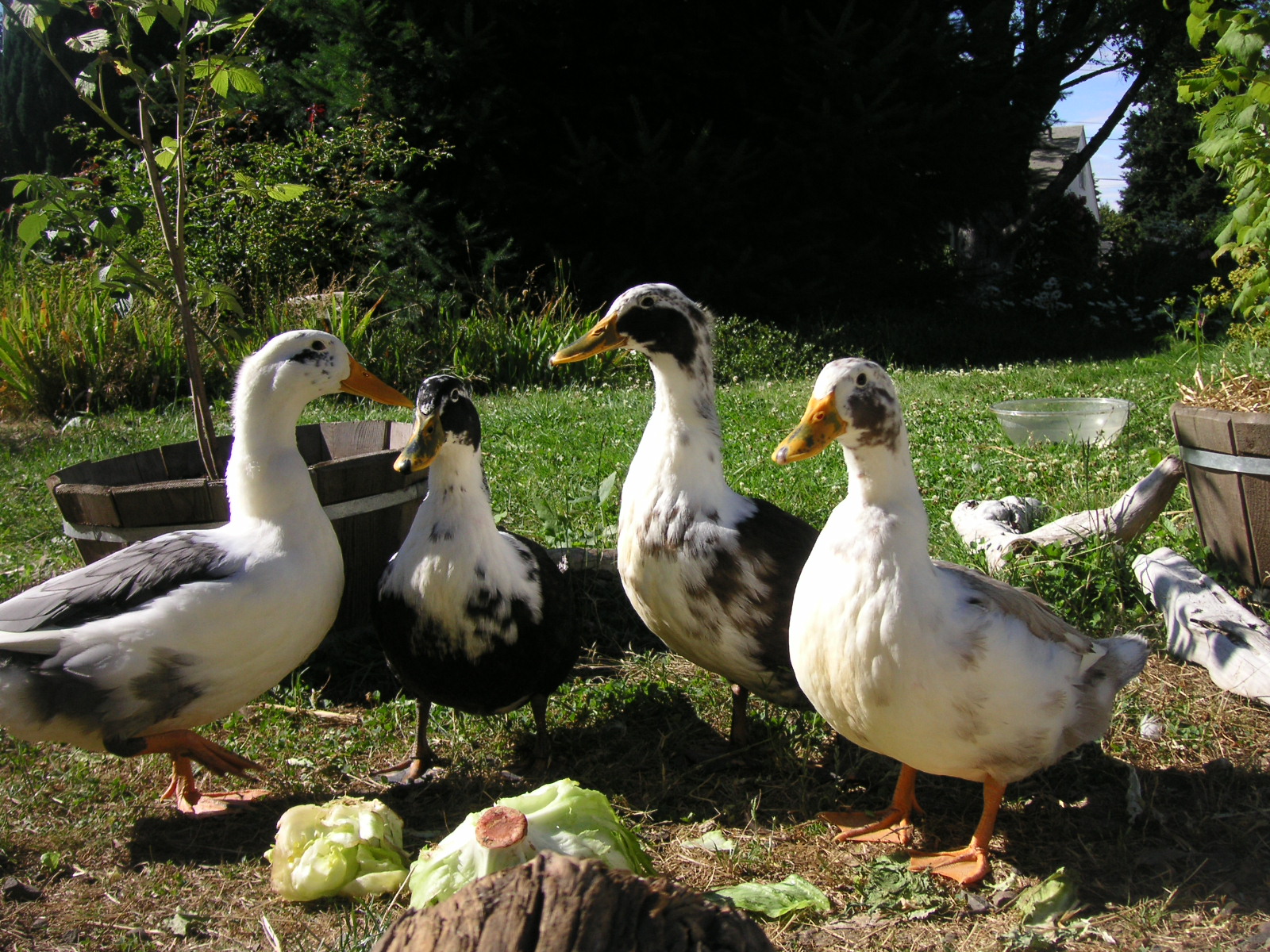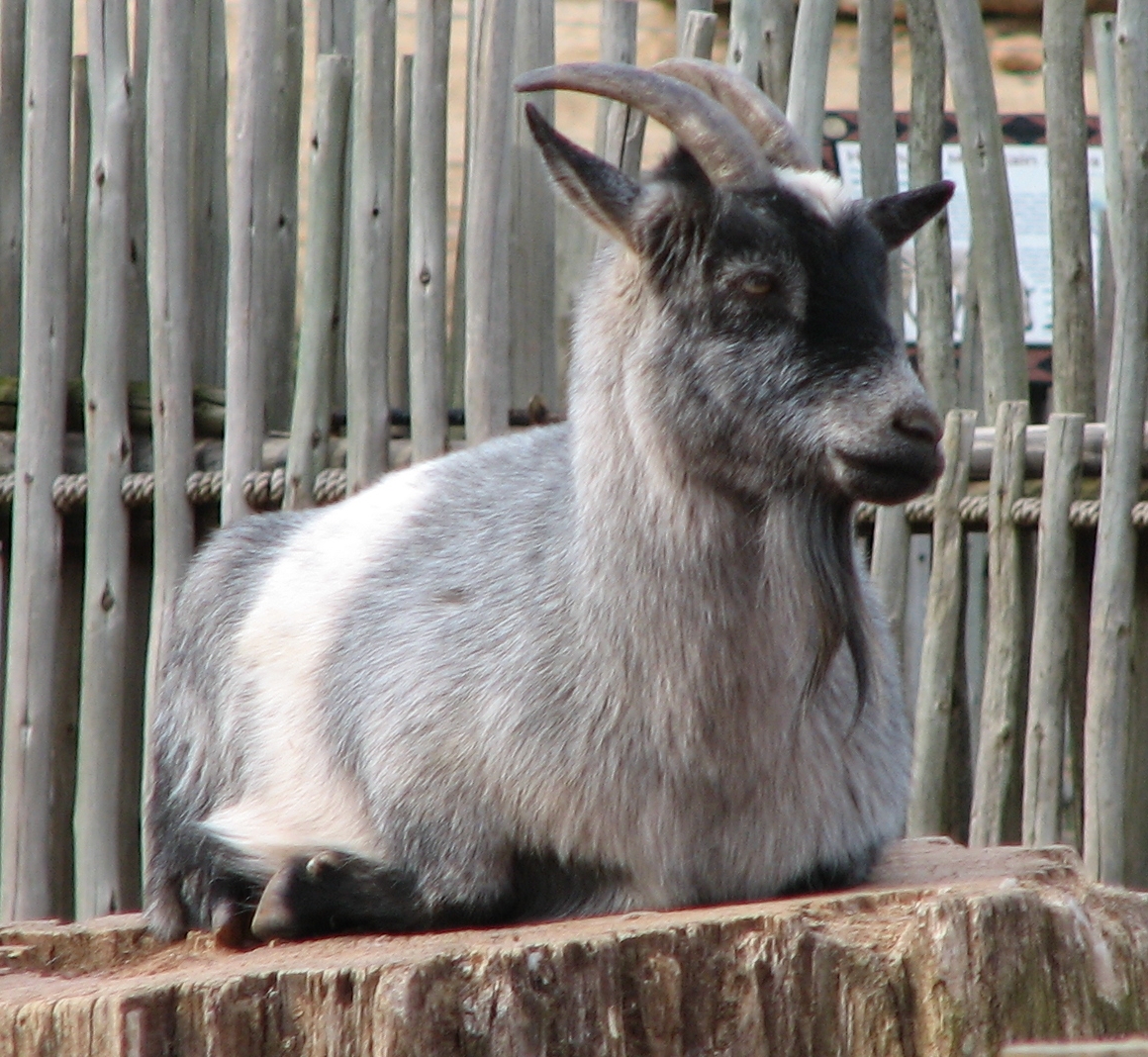|
Khaki Campbell
The Campbell is a British breed of domestic duck. It was developed at Uley, in Gloucestershire, England, at the turn of the 20th century; being introduced to the public in 1898 and the Khaki variety in 1901. History Mrs Adele Campbell GRO & BMD Records commenced poultry-keeping around 1887 and later purchased an Indian Runner Duck of indiscriminate type which was an exceptional layer (182 eggs in 196 days), and which formed the basis in developing the "Campbell Ducks"; in her own words "Various matings of Rouen, Indian Runner and Wild Duck were resorted to produce them". The resulting birds were prolific layers. The "Campbell" breed was introduced to the public in 1898. In an attempt to create a more attractive buff-coloured duck Mrs. Campbell resorted to further cross-matings. The resulting progeny, introduced to the Public in January 1901, is alleged to have reminded Mrs. Campbell of British army uniforms, hence naming this new colour-form "Khaki Campbell Duck". The Khak ... [...More Info...] [...Related Items...] OR: [Wikipedia] [Google] [Baidu] |
Duck
Duck is the common name for numerous species of waterfowl in the family Anatidae. Ducks are generally smaller and shorter-necked than swans and geese, which are members of the same family. Divided among several subfamilies, they are a form taxon; they do not represent a monophyletic group (the group of all descendants of a single common ancestral species), since swans and geese are not considered ducks. Ducks are mostly aquatic birds, and may be found in both fresh water and sea water. Ducks are sometimes confused with several types of unrelated water birds with similar forms, such as loons or divers, grebes, gallinules and coots. Etymology The word ''duck'' comes from Old English 'diver', a derivative of the verb 'to duck, bend down low as if to get under something, or dive', because of the way many species in the dabbling duck group feed by upending; compare with Dutch and German 'to dive'. This word replaced Old English / 'duck', possibly to avoid conf ... [...More Info...] [...Related Items...] OR: [Wikipedia] [Google] [Baidu] |
List Of Duck Breeds
This is a list of the breeds of domestic duck which have official recognition at national or international level. Most breeds of duck derive from the wild mallard, ''Anas platyrhyncos'', while a small minority are descendants of the Muscovy duck, ''Cairina moschata''. Duck breeds are normally officially recognized and described by a national body such as a ministry of agriculture. In some countries they may be recognized by groups of enthusiasts or breeders' associations, which may also draw up a breed standard. Among these are: * the American Poultry Association in the United States * the Poultry Club of Great Britain * the in EuropeEntente EuropéenneListing of European Poultry Breeds and Colours * the Australian Poultry Standards A * Abacot Ranger (also known as ''Streicher'') * African Duck * Alabio Duck *Allier Duck *American Pekin (EE; = ''Pekin Duck'', APA) * Ancona duck *Antigua and Barbuda Duck *Appleyard (APA; = '' Silver Appleyard'', PCGB) * Australian Call *Au ... [...More Info...] [...Related Items...] OR: [Wikipedia] [Google] [Baidu] |
Domestic Duck
The domestic duck or domestic mallard (''Anas platyrhynchos domesticus'') is a subspecies of mallard that has been domesticated by humans and raised for meat, eggs, and down feathers. A few are also kept for show, as pets, or for their ornamental value. Almost all varieties of domesticated ducks, apart from the domestic Muscovy duck (''Cairina moschata''), are descended from the mallard. Domestication Whole-genome sequencing indicate that domestic ducks originate from a single domestication event of mallards during the Neolithic, followed by rapid selection for lineages favoring meat or egg production. They were likely domesticated in Southeast Asia (most likely Southern China) by the rice paddy-farming ancestors of modern Southeast Asians. The date of domestication is unknown due to the scarcity of archaeological records. They spread outwards from the region, first being mentioned in Han Chinese written records in central China by around 500 BC. Duck farming for both meat ... [...More Info...] [...Related Items...] OR: [Wikipedia] [Google] [Baidu] |
Uley
Uley is a village and civil parish in the county of Gloucestershire, England. The parish includes the hamlets of Elcombe and Shadwell and Bencombe, all to the south of the village of Uley, and the hamlet of Crawley to the north. The village is situated in a wooded valley in the Cotswold escarpment, on the B4066 road between Dursley and Stroud. The population of the civil parish is around 1,100, but was much greater during the early years of the industrial revolution, when the village was renowned for producing blue cloth. The placename (recorded as ''Euuelege'' in the Domesday Book) probably signifies 'clearing in a yew wood'. History The Romans built a temple at West Hill, near Uley, on the site of an earlier prehistoric shrine. Following the laying of a water main pipe there in 1976, many discoveries were made including numerous Roman writing tablets or lead curse tablets from the temple area. These writing tablets appear often to relate to theft, and here the mentio ... [...More Info...] [...Related Items...] OR: [Wikipedia] [Google] [Baidu] |
Gloucestershire
Gloucestershire ( abbreviated Glos) is a county in South West England. The county comprises part of the Cotswold Hills, part of the flat fertile valley of the River Severn and the entire Forest of Dean. The county town is the city of Gloucester and other principal towns and villages include Cheltenham, Cirencester, Kingswood, Bradley Stoke, Stroud, Thornbury, Yate, Tewkesbury, Bishop's Cleeve, Churchdown, Brockworth, Winchcombe, Dursley, Cam, Berkeley, Wotton-under-Edge, Tetbury, Moreton-in-Marsh, Fairford, Lechlade, Northleach, Stow-on-the-Wold, Chipping Campden, Bourton-on-the-Water, Stonehouse, Nailsworth, Minchinhampton, Painswick, Winterbourne, Frampton Cotterell, Coleford, Cinderford, Lydney and Rodborough and Cainscross that are within Stroud's urban area. Gloucestershire borders Herefordshire to the north-west, Worcestershire to the north, Warwickshire to the north-east, Oxfordshire to the east, Wiltshire to the south, Bristol ... [...More Info...] [...Related Items...] OR: [Wikipedia] [Google] [Baidu] |
Campbell Mallard
Campbell may refer to: People Surname * Campbell (surname), includes a list of people with surname Campbell Given name * Campbell Brown (footballer), an Australian rules footballer * Campbell Brown (journalist) (born 1968), American television news reporter and anchor * Campbell Cowan Edgar (1870–1938), Scottish Egyptologist and Secretary-General of the Egyptian Museum at Cairo * Campbell Jackson (born 1981), Northern Irish darts player * Campbell Johnstone (born 1980), New Zealand rugby union player * Campbell "Stretch" Miller (1910–1972), American sportscaster * Campbell Money (born 1960), Scottish footballer * Campbell Newman (born 1963), Australian politician * Campbell Scott (born 1961), American actor, director, and voice artist Places In Australia: * Campbell, Australian Capital Territory, a suburb of Canberra, Australia In Canada: * Campbell, Nova Scotia, on Cape Breton Island Nova Scotia * Campbell Branch Little Black River, South of Quebec, Canada (and Mai ... [...More Info...] [...Related Items...] OR: [Wikipedia] [Google] [Baidu] |
British Army Uniform
British may refer to: Peoples, culture, and language * British people, nationals or natives of the United Kingdom, British Overseas Territories, and Crown Dependencies. ** Britishness, the British identity and common culture * British English, the English language as spoken and written in the United Kingdom or, more broadly, throughout the British Isles * Celtic Britons, an ancient ethno-linguistic group * Brittonic languages, a branch of the Insular Celtic language family (formerly called British) ** Common Brittonic, an ancient language Other uses *'' Brit(ish)'', a 2018 memoir by Afua Hirsch *People or things associated with: ** Great Britain, an island ** United Kingdom, a sovereign state ** Kingdom of Great Britain (1707–1800) ** United Kingdom of Great Britain and Ireland (1801–1922) See also * Terminology of the British Isles * Alternative names for the British * English (other) * Britannic (other) * British Isles * Brit (other) * ... [...More Info...] [...Related Items...] OR: [Wikipedia] [Google] [Baidu] |
American Standard Of Perfection
The ''American Standard of Perfection'' is the official breed standard for the poultry fancy in North America. First published in 1874 by the American Poultry Association, the ''Standard of Perfection'' (commonly referred to as "the ''Standard''") classifies and describes the standard physical appearance, coloring and temperament for all recognized breeds of poultry, including chickens, ducks, turkeys, and geese. The current edition was published in 2015. Use The ''Standard'' is used by American Poultry Association judges at sanctioned poultry shows to judge poultry, and by those who participate in the competitive showing of selectively bred birds that conform to the standard, which led to the term "standard bred" poultry. History The first edition of the book listed 41 breeds, and today's versions have nearly 60. There are 19 classes of poultry recognized by the American Poultry Association. Eleven of these classes are devoted to chickens, of which six are classes of large br ... [...More Info...] [...Related Items...] OR: [Wikipedia] [Google] [Baidu] |
American Livestock Breeds Conservancy
The Livestock Conservancy, formerly known as the American Livestock Breeds Conservancy (ALBC) and prior to that, the American Minor Breeds Conservancy, is a nonprofit organization focused on preserving and promoting rare breeds, also known as "heritage breeds" of livestock. Founded in 1977, through the efforts of livestock breed enthusiasts concerned about the disappearance of many of the US's heritage livestock breeds, the Conservancy was the pioneer livestock preservation organization in the United States, and remains a leading organization in that field. It has initiated programs that have saved multiple breeds from extinction, and works closely with similar organizations in other countries, including Rare Breeds Canada. With 3,000 members, a staff of nine and a 19-member board of directors, the organization has an operating budget of almost half a million dollars. The Livestock Conservancy maintains a conservation priority list that divides endangered breeds of horses, asses, ... [...More Info...] [...Related Items...] OR: [Wikipedia] [Google] [Baidu] |
Khaki
The color khaki (, ) is a light shade of tan with a slight yellowish tinge. Khaki has been used by many armies around the world for uniforms and equipment, particularly in arid or desert regions, where it provides camouflage relative to sandy or dusty terrain. It has been used as a color name in English since 1848 when it was first introduced as a military uniform. In Western fashion, it is a standard color for smart casual dress trousers for civilians, which are also often called ''khakis''. In British English and some other Commonwealth usage, ''khaki'' may also refer to a shade of green known in the US as olive drab. Etymology ''Khaki'' is a loanword from Urdu خاکی 'soil-colored', which in turn comes from Persian خاک ''khâk'' 'soil' + ی (adjectival ending); it came into English via the British Indian Army. Origin Khaki was first worn as a uniform in the Corps of Guides that was raised in December 1846 by Henry Lawrence (1806–1857), agent to the Governor-Gen ... [...More Info...] [...Related Items...] OR: [Wikipedia] [Google] [Baidu] |
Mallard
The mallard () or wild duck (''Anas platyrhynchos'') is a dabbling duck that breeds throughout the temperate and subtropical Americas, Eurasia, and North Africa, and has been introduced to New Zealand, Australia, Peru, Brazil, Uruguay, Argentina, Chile, Colombia, the Falkland Islands, and South Africa. This duck belongs to the subfamily Anatinae of the waterfowl family Anatidae. Males have purple patches on their wings, while the females (hens or ducks) have mainly brown-speckled plumage. Both sexes have an area of white-bordered black or iridescent blue feathers called a speculum on their wings; males especially tend to have blue speculum feathers. The mallard is long, of which the body makes up around two-thirds the length. The wingspan is and the bill is long. It is often slightly heavier than most other dabbling ducks, weighing . Mallards live in wetlands, eat water plants and small animals, and are social animals preferring to congregate in groups or flocks of va ... [...More Info...] [...Related Items...] OR: [Wikipedia] [Google] [Baidu] |



.jpg)


.jpg)